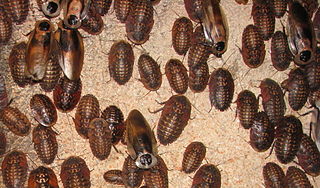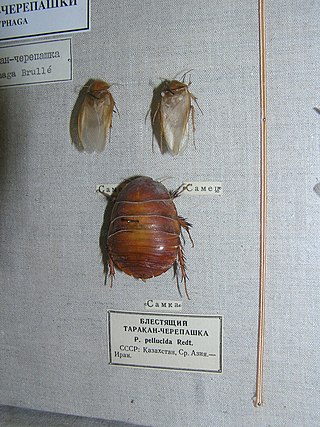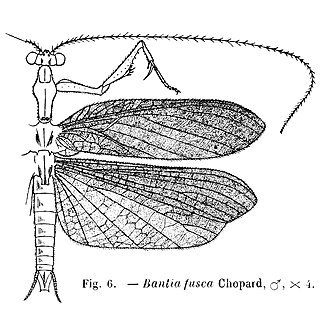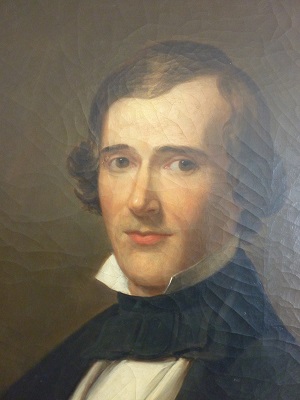
Ferdinand de Saussure was a Swiss linguist, semiotician and philosopher. His ideas laid a foundation for many significant developments in both linguistics and semiotics in the 20th century. He is widely considered one of the founders of 20th-century linguistics and one of two major founders of semiotics, or semiology, as Saussure called it.

Horace Bénédict de Saussure was a Genevan geologist, meteorologist, physicist, mountaineer and Alpine explorer, often called the founder of alpinism and modern meteorology, and considered to be the first person to build a successful solar oven.

The Scoliidae, the scoliid wasps, are a family of wasps comprising about 560 species worldwide. They tend to be black, often marked with yellow or orange, and their wing tips are distinctively corrugated. Males are more slender and elongated than females, with significantly longer antennae, but the sexual dimorphism is not as apparent as in many of the Tiphiidae and Thynnidae.

Henri Louis Frédéric de Saussure was a Swiss mineralogist and entomologist specialising in studies of Hymenoptera and Orthopteroid insects. He also was a prolific taxonomist.

The family Gryllidae contains the subfamilies and genera which entomologists now term true crickets. Having long, whip-like antennae, they belong to the Orthopteran suborder Ensifera, which has been greatly reduced in the last 100 years : taxa such as the spider-crickets and allies, sword-tail crickets, wood or ground crickets and scaly crickets have been elevated to family level. The type genus is Gryllus and the first use of the family name "Gryllidae" was by Francis Walker.

Giant cockroaches, or blaberids, are the second-largest cockroach family by number of species. Mostly distributed in warmer climates worldwide, this family is based on the American genus Blaberus, but much of the diversity is also found in Africa and Asia.

Nicolas-Théodore de Saussure was a Swiss chemist and student of plant physiology who made seminal advances in phytochemistry. He is one of the major pioneers in the study of photosynthesis.

Ectobiidae is a family of the order Blattodea (cockroaches). This family contains many of the smaller common household pest cockroaches, among others. They are sometimes called wood cockroaches. A few notable species include:

Corydiidae, previously known as Polyphagidae, is a family of the order Blattodea (cockroaches). Many are known as sand cockroaches. The family is divided into five subfamilies, comprising some 40 genera. One prominent species is the desert cockroach, Arenivaga investigata.

Bandwings, or band-winged grasshoppers, are the subfamily Oedipodinae of grasshoppers classified under the family Acrididae. They have a worldwide distribution and were originally elevated to full family status as the Oedipodidae. Many species primarily inhabit xeric weedy fields, and some are considered to be important locusts:

The expression Geneva School refers to (1) a group of linguists based in Geneva who pioneered modern structural linguistics and (2) a group of literary theorists and critics working from a phenomenological perspective.

Charles Bally was a Swiss linguist from the Geneva School. He lived from 1865 to 1947 and was, like Ferdinand de Saussure, from Switzerland. His parents were Jean Gabriel, a teacher, and Henriette, the owner of a cloth store. Bally was married three times: first to Valentine Leirens, followed by Irma Baptistine Doutre, who was sent into a mental institution in 1915, and finally with Alice Bellicot. In addition to his edition of de Saussure's lectures, Course in General Linguistics, Charles Bally also played an important role in linguistics.

Delta is an Old World genus of potter wasps with species predominantly distributed through tropical Africa and Asia. Some species are present in the Palearctic region, and a few have been introduced in the Nearctic and Neotropical regions. The members of this genus have a long metasomal petiole, like members of the genera Eumenes and Zeta.
Hypodynerus is a South American, primarily Andean, genus of potter wasps with most of its described species inhabiting Chile. The species included in Hypodynerus include:

Thespidae is a family of insects in the order Mantodea. Following a major revision of this order in 2019, the old-world subfamilies Haaniinae and Hoplocoryphinae, previously placed here, have been upgraded to family level. Many genera are Neotropical, but the Thespinae are represented in Africa, Asia, Europe, and North America.

Panchlora is a genus of cockroaches in the subfamily Panchlorinae, erected by Hermann Burmeister in 1838. Species are mostly found in the Americas and Africa. Most species in this genus are green in colour, but some are cream or grey.

The so-called Top of the Mont Blanc is a collection piece on display in the Oval Room of Teylers Museum. The specimen was cut off from the highest findable piece of exposed rock of the Rocher de la Tournette, 4,677 metres (15,344 ft) high on the snow covered summit ridge of the Mont Blanc on 3 August 1787, during one of the first climbs of the mountain by the Swiss scientific pioneer Horace Bénédict de Saussure.

Wilmot Gibbes de Saussure was a brigadier general in the South Carolina militia, who served along with the Confederate States Army in South Carolina at various times during the American Civil War. As a colonel, he led his regiment in the occupation of Fort Moultrie and the bombardment of Fort Sumter at the beginning of the war. He was appointed brigadier general as well as adjutant general and inspector general of South Carolina militia in 1862. He commanded part of the Charleston defenses during the Union siege of the city in 1863. He also led his men in opposition to Major General William T. Sherman's march through the Carolinas.

Gryllini is a tribe of crickets and typical of the family Gryllidae. Species are terrestrial, carnivorous or omnivorous and can be found in all continenents except Antarctica.

Corydiinae is a subfamily of the order Blattodea (cockroaches). Many are known as sand cockroaches. The subfamily, comprising about 20 genera, contains half the genera in Corydiidae. One prominent species is the desert cockroach, Arenivaga investigata.

















